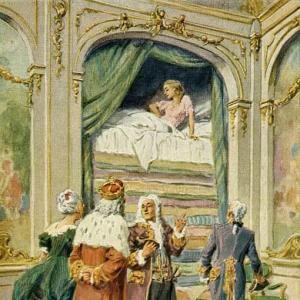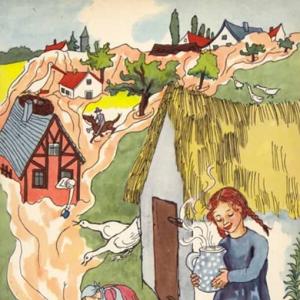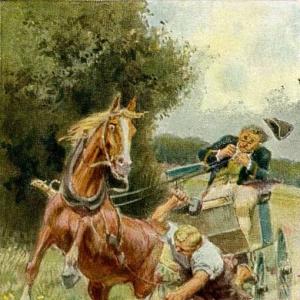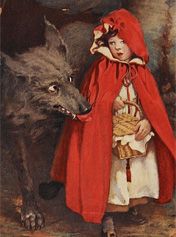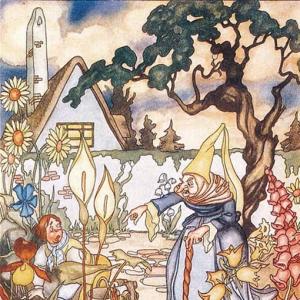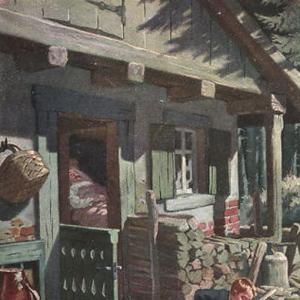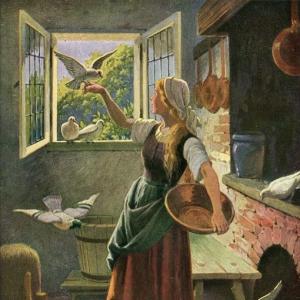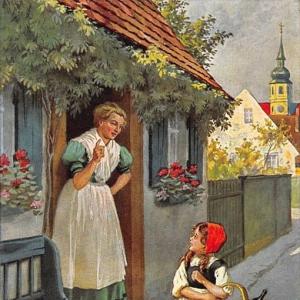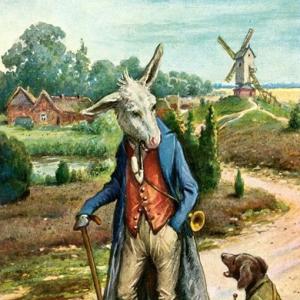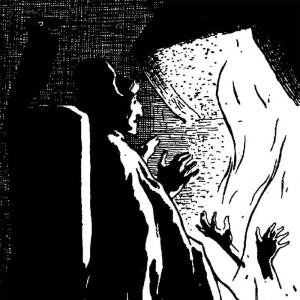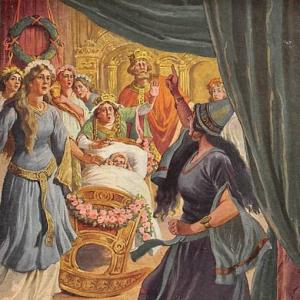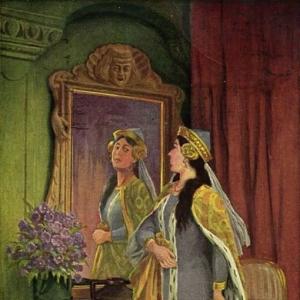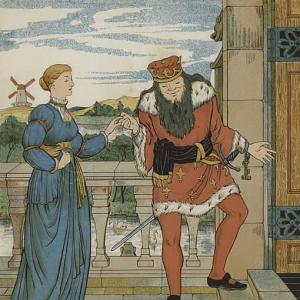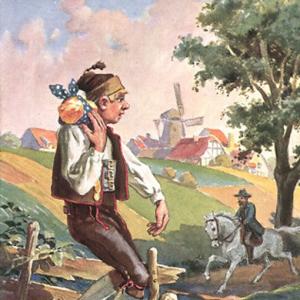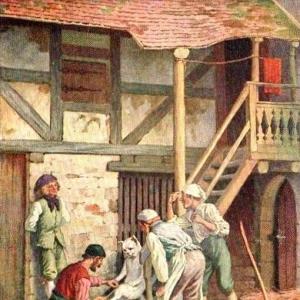Reading time: 17 min
There were once three brothers who had fallen deeper and deeper into poverty, and at last their need was so great that they had to endure hunger, and had nothing to eat or drink. Then said they, „We cannot go on thus, we had better go into the world and seek our fortune.“ They therefore set out, and had already walked over many a long road and many a blade of grass, but had not yet met with good luck. One day they arrived in a great forest, and in the midst of it was a hill, and when they came nearer they saw that the hill was all silver. Then spoke the eldest, „Now I have found the good luck I wished for, and I desire nothing more.“
He took as much of the silver as he could possibly carry, and then turned back and went home again. But the two others said, „We want something more from good luck than mere silver,“ and did not touch it, but went onwards. After they had walked for two days longer without stopping, they came to a hill which was all gold. The second brother stopped, took thought with himself, and was undecided. „What shall I do?“ said he. „Shall I take for myself so much of this gold, that I have sufficient for all the rest of my life, or shall I go farther?“ At length he made a decision, and putting as much into his pockets as would go in, said farewell to his brother, and went home.
But the third said, „Silver and gold do not move me, I will not renounce my chance of fortune, perhaps something better still will be given me.“ He journeyed onwards, and when he had walked for three days, he got into a forest which was still larger than the one before, and never would come to an end, and as he found nothing to eat or to drink, he was all but exhausted. Then he climbed up a high tree to find out if up there he could see the end of the forest, but so far as his eye could pierce he saw nothing but the tops of trees.
Then he began to descend the tree again, but hunger tormented him, and he thought to himself, „If I could but eat my fill once more!“ When he got down he saw with astonishment a table beneath the tree richly spread with food, the steam of which rose up to meet him. „This time,“ said he, „my wish has been fulfilled at the right moment.“ And without inquiring who had brought the food, or who had cooked it, he approached the table, and ate with enjoyment until he had appeased his hunger. When he was done, he thought, „It would after all be a pity if the pretty little table-cloth were to be spoilt in the forest here,“ and folded it up tidily and put it in his pocket.
Then he went onwards, and in the evening, when hunger once more made itself felt, he wanted to make a trial of his little cloth, and spread it out and said, „I wish thee to be covered with good cheer again,“ and scarcely had the wish crossed his lips than as many dishes with the most exquisite food on them stood on the table as there was room for. „Now I perceive,“ said he, „in what kitchen my cooking is done. Thou shalt be dearer to me than the mountains of silver and gold.“ For he saw plainly that it was a wishing-cloth. The cloth, however, was still not enough to enable him to sit down quietly at home. He preferred to wander about the world and pursue his fortune farther.
One night he met, in a lonely wood, a dusty, black charcoal-burner, who was burning charcoal there, and had some potatoes by the fire, on which he was going to make a meal. „Good evening, blackbird!“ said the youth. „How dost thou get on in thy solitude?“ – „One day is like another,“ replied the charcoal-burner, „and every night potatoes! Hast thou a mind to have some, and wilt thou be my guest?“ – „Many thanks,“ replied the traveler, „I won’t rob thee of thy supper. Thou didst not reckon on a visitor, but if thou wilt put up with what I have, thou shalt have an invitation.“ – „Who is to prepare it for thee?“ said the charcoal-burner.
„I see that thou hast nothing with thee, and there is no one within a two hours‘ walk who could give thee anything.“ – „And yet there shall be a meal,“ answered the youth, „and better than any thou hast ever tasted.“ Thereupon he brought his cloth out of his knapsack, spread it on the ground, and said, „Little cloth, cover thyself,“ and instantly boiled meat and baked meat stood there, and as hot as if it had just come out of the kitchen. The charcoal-burner stared, but did not require much pressing. He fell to, and thrust larger and larger mouthfuls into his black mouth.
When they had eaten everything, the charcoal-burner smiled contentedly, and said, „Hark thee, thy table-cloth has my approval. It would be a fine thing for me in this forest, where no one ever cooks me anything good. I will propose an exchange to thee. There in the corner hangs a soldier’s knapsack, which is certainly old and shabby, but in it lie concealed wonderful powers. But, as I no longer use it, I will give it to thee for the table-cloth.“ – „I must first know what these wonderful powers are,“ answered the youth.
„That will I tell thee,“ replied the charcoal-burner. „Every time thou tappest it with thy hand, a corporal comes with six men armed from head to foot, and they do whatsoever thou commandest them.“ – „So far as I am concerned,“ said the youth, „if nothing else can be done, we will exchange,“ and he gave the charcoal-burner the cloth, took the knapsack from the hook, put it on, and bade farewell. When he had walked a while, he wished to make a trial of the magical powers of his knapsack and tapped it. Immediately the seven warriors stepped up to him, and the corporal said, „What does my lord and ruler wish for?“ – „March with all speed to the charcoal-burner, and demand my wishing-cloth back.“
They faced to the left, and it was not long before they brought what he required, and had taken it from the charcoal-burner without asking many questions. The young man bade them retire, went onwards, and hoped fortune would shine yet more brightly on him. By sunset he came to another charcoal-burner, who was making his supper ready by the fire. „If thou wilt eat some potatoes with salt, but with no dripping, come and sit down with me,“ said the sooty fellow. „No, he replied, this time thou shalt be my guest,“ and he spread out his cloth, which was instantly covered with the most beautiful dishes. They ate and drank together, and enjoyed themselves heartily.
After the meal was over, the charcoal-burner said, „Up there on that shelf lies a little old worn-out hat which has strange properties: when any one puts it on, and turns it round on his head, the cannons go off as if twelve were fired all together, and they shoot down everything so that no one can withstand them. The hat is of no use to me, and I will willingly give it for thy table-cloth.“ – „That suits me very well,“ he answered, took the hat, put it on, and left his table-cloth behind him. Hardly, however, had he walked away than he tapped on his knapsack, and his soldiers had to fetch the cloth back again.
„One thing comes on the top of another,“ thought he, „and I feel as if my luck had not yet come to an end.“ Neither had his thoughts deceived him. After he had walked on for the whole of one day, he came to a third charcoal-burner, who like the previous ones, invited him to potatoes without dripping. But he let him also dine with him from his wishing-cloth, and the charcoal-burner liked it so well, that at last he offered him a horn for it, which had very different properties from those of the hat. When any one blew it all the walls and fortifications fell down, and all towns and villages became ruins.
He certainly gave the charcoal-burner the cloth for it, but he afterwards sent his soldiers to demand it back again, so that at length he had the knapsack, hat and horn, all three. „Now,“ said he, „I am a made man, and it is time for me to go home and see how my brothers are getting on.“ When he reached home, his brothers had built themselves a handsome house with their silver and gold, and were living in clover. He went to see them, but as he came in a ragged coat, with his shabby hat on his head, and his old knapsack on his back, they would not acknowledge him as their brother. They mocked and said, „Thou givest out that thou art our brother who despised silver and gold, and craved for something still better for himself.
He will come in his carriage in full splendour like a mighty king, not like a beggar,“ and they drove him out of doors. Then he fell into a rage, and tapped his knapsack until a hundred and fifty men stood before him armed from head to foot. He commanded them to surround his brothers‘ house, and two of them were to take hazel-sticks with them, and beat the two insolent men until they knew who he was. A violent disturbance arose, people ran together, and wanted to lend the two some help in their need, but against the soldiers they could do nothing.
News of this at length came to the King, who was very angry, and ordered a captain to march out with his troop, and drive this disturber of the peace out of the town; but the man with the knapsack soon got a greater body of men together, who repulsed the captain and his men, so that they were forced to retire with bloody noses. The King said, „This vagabond is not brought to order yet,“ and next day sent a still larger troop against him, but they could do even less. The youth set still more men against them, and in order to be done the sooner, he turned his hat twice round on his head, and heavy guns began to play, and the king’s men were beaten and put to flight.
„And now,“ said he, „I will not make peace until the King gives me his daughter to wife, and I govern the whole kingdom in his name.“ He caused this to be announced to the King, and the latter said to his daughter, „Necessity is a hard nut to crack, what remains to me but to do what he desires? If I want peace and to keep the crown on my head, I must give thee away.“ So the wedding was celebrated, but the King’s daughter was vexed that her husband should be a common man, who wore a shabby hat, and put on an old knapsack. She wished much to get rid of him, and night and day studied how she could accomplished this.
Then she thought to herself, „Is it possible that his wonderful powers lie in the knapsack?“ and she dissembled and caressed him, and when his heart was softened, she said, „If thou wouldst but lay aside that ugly knapsack, it makes disfigures thee so, that I can’t help being ashamed of thee.“ – „Dear child,“ said he, „this knapsack is my greatest treasure. As long as I have it, there is no power on earth that I am afraid of.“ And he revealed to her the wonderful virtue with which it was endowed. Then she threw herself in his arms as if she were going to kiss him, but dexterously took the knapsack off his shoulders, and ran away with it.
As soon as she was alone she tapped it, and commanded the warriors to seize their former master, and take him out of the royal palace. They obeyed, and the false wife sent still more men after him, who were to drive him quite out of the country. Then he would have been ruined if he had not had the little hat. But his hands were scarcely at liberty before he turned it twice. Immediately the cannon began to thunder, and struck down everything, and the King’s daughter herself was forced to come and beg for mercy. As she entreated in such moving terms, and promised amendment, he allowed himself to be persuaded and granted her peace.
She behaved in a friendly manner to him, and acted as if she loved him very much, and after some time managed so to befool him, that he confided to her that even if someone got the knapsack into his power, he could do nothing against him so long as the old hat was still his. When she knew the secret, she waited until he was asleep, and then she took the hat away from him, and had it thrown out into the street. But the horn still remained to him, and in great anger he blew it with all his strength.
Instantly all walls, fortifications, towns, and villages, toppled down, and crushed the King and his daughter to death. And had he not put down the horn and had blown just a little longer, everything would have been in ruins, and not one stone would have been left standing on another. Then no one opposed him any longer, and he made himself King of the whole country.
 Learn languages. Double-tap on a word.Learn languages in context with Childstories.org and Deepl.com.
Learn languages. Double-tap on a word.Learn languages in context with Childstories.org and Deepl.com.Backgrounds
Interpretations
Adaptions
Summary
Linguistics
„The Knapsack, the Hat, and the Horn“ is a lesser-known fairy tale collected by the Brothers Grimm in their famous anthology „Grimms‘ Fairy Tales“ or „Kinder- und Hausmärchen.“ Like the other tales in their collection, this story has its roots in the rich oral storytelling traditions of Germany and Europe. The Brothers Grimm, Jacob and Wilhelm, aimed to preserve and document the oral traditions of German and European folklore that had been passed down through generations. They collected stories from various sources, including friends, family, and acquaintances, and edited them to create a cohesive collection of tales. By doing so, they aimed to preserve the cultural heritage of their time.
This fairy tale shares themes and motifs with other European folktales, such as the power of magical items, sibling rivalry, and the importance of cleverness and resourcefulness. As with many of the tales collected by the Brothers Grimm, „The Knapsack, the Hat, and the Horn“ has evolved and changed through oral storytelling over time. The Grimm brothers‘ version of the story reflects both the original oral tradition and the literary sensibilities of early 19th-century Germany. Despite not being as well-known as some of the other tales in the Grimms‘ collection, „The Knapsack, the Hat, and the Horn“ offers a captivating story that showcases the power of magical items and the importance of cleverness and resourcefulness in overcoming challenges.
„The Knapsack, the Hat, and the Horn“ is a German fairy tale collected by the Brothers Grimm in their famous book „Grimm’s Fairy Tales“ (also known as „Children’s and Household Tales“ or „Kinder- und Hausmärchen“ in German). The Brothers Grimm, Jacob and Wilhelm, were German academics, philologists, and lexicographers who dedicated themselves to collecting and publishing folklore during the 19th century. Their work has become synonymous with traditional European folk and fairy tales.
The story of „The Knapsack, the Hat, and the Horn“ revolves around three brothers who set out to find their fortunes in the world. Along the way, they encounter magical items that grant them great power, including a knapsack that can summon soldiers, a hat that can make its wearer invisible, and a horn that can destroy anything when blown. The tale explores themes of greed, the consequences of deception, and the corrupting influence of power. As with many of the Brothers Grimm’s fairy tales, „The Knapsack, the Hat, and the Horn“ has roots in Germanic and European folklore, with variations of the story appearing in different cultures. The tale is not as widely known as some of the other Grimm’s Fairy Tales, such as „Cinderella,“ „Snow White,“ or „Hansel and Gretel,“ but it remains an important part of their collection and offers valuable lessons and insights into human nature and morality.
„The Knapsack, the Hat, and the Horn“ is a fairy tale collected by the Brothers Grimm that offers various themes and interpretations. Here are some possible interpretations of the story.
The Power of Magical Items: The tale centers around the three magical items inherited by the brothers: the knapsack, the hat, and the horn. These items grant the brothers extraordinary powers, highlighting the theme of the power and importance of magical objects in traditional fairy tales.
Sibling Rivalry and Cooperation: The story explores the dynamics between the three brothers as they venture into the world. While there is some rivalry between them, they ultimately work together to overcome obstacles and achieve success. This interpretation emphasizes the importance of sibling relationships and the value of cooperation.
Cleverness and Resourcefulness: The brothers use their magical items in creative ways to overcome challenges and defeat their enemies. This interpretation focuses on the importance of intelligence, wit, and resourcefulness in facing adversity and achieving one’s goals.
The Quest for Wealth and Power: The brothers‘ journey is driven by their desire to achieve wealth and power, which they eventually attain through their adventures and the use of their magical items. This interpretation highlights the theme of ambition and the pursuit of material success.
The Role of Fate and Destiny: The brothers are given magical items by their father, which sets them on their path and determines the course of their lives. This interpretation explores the role of fate and destiny in shaping one’s life and experiences.
Greed and Materialism: The three brothers each seek their fortune, but their desires differ. The eldest brother is content with the silver, and the second with gold, while the third brother pursues something greater. This highlights how the pursuit of wealth and material possessions can be all-consuming, but may not bring true happiness or fulfillment. The third brother eventually gains magical items that grant him great power, showing that there are things beyond material wealth that can be more valuable. As the brothers accumulate wealth and power, they also encounter dangers and challenges. This interpretation suggests that the pursuit of material wealth can come with its own set of consequences and pitfalls.
The Consequences of Deception: Throughout the story, the King’s daughter consistently deceives her husband to gain control of his magical items. Her deceptive nature ultimately leads to her and her father’s demise, as the third brother uses the power of the horn to destroy the kingdom. This underlines the idea that dishonesty and manipulation can lead to devastating consequences, both for the deceiver and those around them.
Power and its Corrupting Influence: As the third brother acquires the magical knapsack, hat, and horn, he becomes increasingly powerful and uses these powers against his own brothers and the King’s forces. The story highlights the potential for power to corrupt individuals, leading them to act in ways they might not have before. In the end, the third brother becomes the ruler of the entire country, emphasizing that power can change a person’s destiny, but also warns of the dangers of unchecked power and the consequences it can bring.
Overall, „The Knapsack, the Hat, and the Horn“ offers various themes and moral lessons that can resonate with readers and listeners of all ages. The story’s timeless messages about the power of magical items, the importance of cooperation, and the value of cleverness and resourcefulness continue to captivate and inspire audiences across different cultures and generations. „The Knapsack, the Hat, and the Horn“ can be seen as a cautionary tale warning against greed, deception, and the corrupting influence of power.
While „The Knapsack, the Hat, and the Horn“ is not as well-known as some other Brothers Grimm fairy tales, it has still inspired various adaptations and references in different media forms. Here are a few specific examples.
Literature: The story has been retold and adapted in various fairy tale anthologies and collections, often with slight changes or a modern touch to make it more accessible to contemporary audiences. The story has been adapted into numerous children’s books, often with different illustrations and retellings of the tale. Some popular adaptations include „The Wishing Table“ by Louise Rowe, „The Magic Table“ by Maria Tatar, and „The Magic Knapsack“ by Alison Uttley.
Theater: The story has also been adapted into several stage productions, including musicals and plays. One example is the musical „The Wishing Table“ by Eric Lane Barnes, which was performed by the Pittsburgh Opera in 2018. Although there are no widely-known stage adaptations of „The Knapsack, the Hat, and the Horn,“ smaller theater groups and community theaters may have adapted the tale as a play or musical for local audiences.
Art and Illustration: Many artists have created illustrations for this fairy tale in different styles, ranging from classic to modern interpretations. These visual adaptations can be found in illustrated books, art prints, or online galleries.
Educational Materials: The story has been used in educational contexts, such as lesson plans, classroom activities, or worksheets that explore the themes and morals of the story. Teachers may use the tale to teach about cooperation, resourcefulness, or the consequences of greed.
„The Knapsack, the Hat, and the Horn“ is a classic fairy tale that has been adapted in various forms over the years. Although „The Knapsack, the Hat, and the Horn“ may not have as many high-profile adaptations as some other Brothers Grimm tales, it still provides a wealth of themes and motifs that can inspire new versions and interpretations. Its story of magical items, sibling dynamics, and the quest for wealth and power remains relevant and engaging for contemporary audiences.
„The Knapsack, the Hat, and the Horn“ is a fairy tale by the Brothers Grimm about three brothers who set out to seek their fortune. The eldest brother finds a hill of silver and decides to take his share, while the other two brothers continue their journey. The second brother comes across a hill of gold and takes his share, leaving the third brother to venture alone. The third brother discovers a wishing-cloth that provides food on command and exchanges it for a magical knapsack, hat, and horn. The knapsack summons soldiers, the hat unleashes a powerful cannon, and the horn destroys walls and buildings.
The third brother returns home to find his siblings living in wealth, but they refuse to recognize him due to his ragged appearance. Angry, he uses the knapsack to command soldiers to punish his brothers. The King tries to suppress the brother’s forces but fails, ultimately conceding his daughter’s hand in marriage to the brother, who becomes the ruler in the King’s name.
Although the princess initially plots to remove her husband’s powers by stealing his magical items, she is forced to beg for mercy when he uses the hat’s power. He forgives her, but she continues to deceive him and eventually learns the secret of the hat’s invincibility. She steals the hat, but the brother still has the horn, which he uses to bring destruction upon the kingdom, killing the King and his daughter. With no one left to oppose him, the brother becomes King of the entire country.
Linguistic analysis focuses on examining the language and structure of a text to uncover underlying meanings, themes, and stylistic features. Let’s analyze „The Knapsack, the Hat, and the Horn“ by the Brothers Grimm for its linguistic elements:
Narrative Structure
The story follows a classic fairy tale structure: a quest narrative where characters go out into the world seeking fortune. It features a tripartite sequence, with each brother encountering a different magical opportunity. This use of threes is common in folklore, instilling a rhythmic and memorable progression. The youngest brother’s perseverance and eventual triumph are hallmarks of a moralistic fairy tale, illustrating themes of patience and wisdom.
Characterization: The language used in dialogue and description provides insight into characters‘ personalities and values. The eldest brother values immediate wealth („silver“), while the youngest seeks something more meaningful. Each character’s speech pattern reflects their role and intelligence; the youngest brother’s clever negotiations and strategic thinking are conveyed through his articulate dialogue.
Symbolism: Objects like the wishing-cloth, knapsack, hat, and horn symbolize power and control over one’s destiny. Silver and gold represent material wealth, juxtaposed with the more powerful and transformative nature of the enchanted items.
Lexical Choices
The language used is typical of fairy tales: formal, with an emphasis on dialogue and vivid descriptions. The frequent use of archaic terms (e. g. , „thee,“ „thou“) adds to the timeless quality of the narrative. Food-related imagery („baked meat“, „potatoes“) ties wealth to basic human needs, contrasting material riches with nourishment and abundance.
Themes: The narrative explores themes of greed, power dynamics, and betrayal, evident in the interactions between the brothers and the protagonist’s eventual dealings with royalty. The motif of magical transformations and exchanges symbolizes the idea that true power lies in wisdom and strategic thinking rather than in material possessions alone.
Moral Lessons: The tale imparts lessons about the dangers of greed and the virtues of patience and cleverness. The youngest brother’s story reflects the rewards of perseverance and intelligent resourcefulness.
Tone and Style: The tone is whimsical yet didactic, typical of fairy tales, aiming to impart moral lessons through fantasy. The narrative style combines straightforward prose with rich, descriptive details, engaging readers while conveying deeper messages.
Overall, „The Knapsack, the Hat, and the Horn“ employs linguistic elements characteristic of fairy tales to craft a story that entertains while imparting wisdom about the true nature of wealth and power.
Information for scientific analysis
Fairy tale statistics | Value |
|---|---|
| Number | KHM 54 |
| Aarne-Thompson-Uther-Index | ATU Typ 569 |
| Translations | DE, EN, DA, ES, PT, IT, JA, NL, PL, RU, TR, VI, ZH |
| Readability Index by Björnsson | 35.3 |
| Flesch-Reading-Ease Index | 75.8 |
| Flesch–Kincaid Grade-Level | 8.3 |
| Gunning Fog Index | 11 |
| Coleman–Liau Index | 8 |
| SMOG Index | 9.3 |
| Automated Readability Index | 8.9 |
| Character Count | 12.372 |
| Letter Count | 9.497 |
| Sentence Count | 104 |
| Word Count | 2.348 |
| Average Words per Sentence | 22,58 |
| Words with more than 6 letters | 299 |
| Percentage of long words | 12.7% |
| Number of Syllables | 3.001 |
| Average Syllables per Word | 1,28 |
| Words with three Syllables | 117 |
| Percentage Words with three Syllables | 5% |
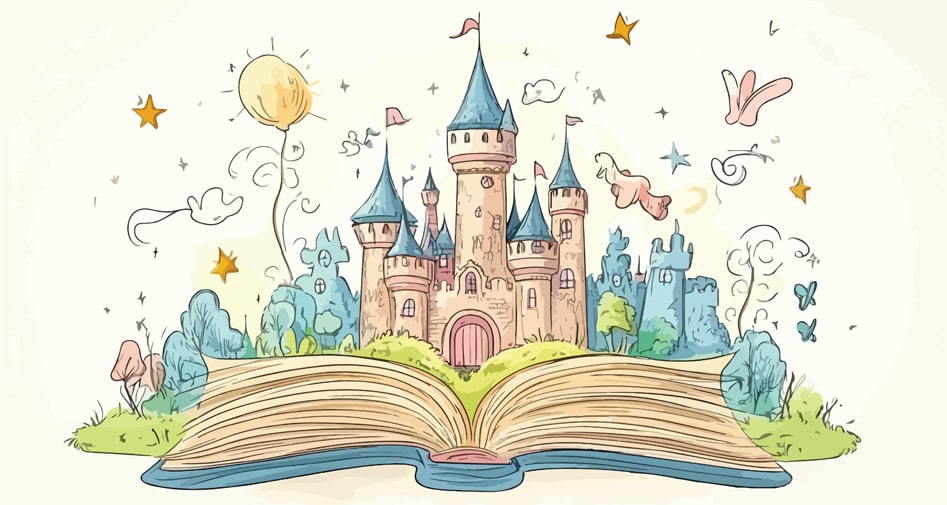
 Facebook
Facebook  Whatsapp
Whatsapp  Messenger
Messenger  Telegram
Telegram Reddit
Reddit